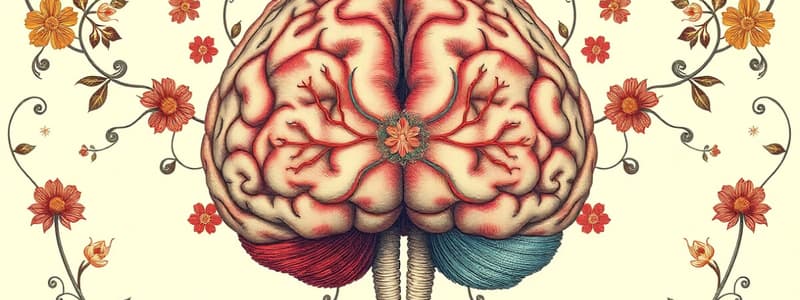Podcast
Questions and Answers
What is the central hypothesis behind performing a corpus callosotomy for patients with severe seizures?
What is the central hypothesis behind performing a corpus callosotomy for patients with severe seizures?
- To allow the brain to create new neural pathways as compensation.
- To increase blood flow to the brain.
- To enhance cognitive function by forcing each hemisphere to work independently.
- To prevent the spread of epileptic activity between the brain's hemispheres. (correct)
In split-brain patients, how do testing scenarios typically reveal the functional specialization of each hemisphere?
In split-brain patients, how do testing scenarios typically reveal the functional specialization of each hemisphere?
- By presenting stimuli to both hemispheres simultaneously and observing the combined response.
- By directing information to only one hemisphere at a time and assessing the individual responses. (correct)
- By measuring the overall brain activity using fMRI during complex tasks.
- By evaluating memory recall tasks involving visual and auditory stimuli.
How does split-brain research contribute to our understanding of consciousness, according to the speech outline?
How does split-brain research contribute to our understanding of consciousness, according to the speech outline?
- It proves that consciousness is primarily located in the right hemisphere, which interprets intentions.
- It challenges the idea of a singular consciousness, suggesting it's a collective of different systems working together. (correct)
- It reveals that consciousness is equally distributed across both hemispheres.
- It supports the idea of a singular, unified consciousness governing all brain functions.
What role does the left hemisphere play in the context of the 'interpreter' concept, as described in the speech outline?
What role does the left hemisphere play in the context of the 'interpreter' concept, as described in the speech outline?
According to the speech outline, what is the primary objective of a corpus callosotomy?
According to the speech outline, what is the primary objective of a corpus callosotomy?
What specific finding from split-brain patient studies supports the idea that the speech center is typically located in the left hemisphere?
What specific finding from split-brain patient studies supports the idea that the speech center is typically located in the left hemisphere?
In the context of split-brain research, what does the 'interpreter' in the left hemisphere do when faced with a behavior initiated by the right hemisphere?
In the context of split-brain research, what does the 'interpreter' in the left hemisphere do when faced with a behavior initiated by the right hemisphere?
According to the speech outline, which cognitive function is predominantly associated with the right hemisphere?
According to the speech outline, which cognitive function is predominantly associated with the right hemisphere?
What is the key difference between how the left and right hemispheres handle cause and effect, as indicated in the speech outline?
What is the key difference between how the left and right hemispheres handle cause and effect, as indicated in the speech outline?
What is the overall message, or thesis, of the speech outline concerning split-brain research and its implications?
What is the overall message, or thesis, of the speech outline concerning split-brain research and its implications?
Flashcards
Corpus Callosotomy
Corpus Callosotomy
A surgical procedure that severs the corpus callosum to treat severe seizures.
Corpus Callosum
Corpus Callosum
Bundle of nerve fibers connecting the two brain hemispheres; severed in corpus callosotomy.
Split-Brain Tests
Split-Brain Tests
Split-brain patients can show information to only one side at a time due to hemispheric separation.
Left Hemisphere Interpreter
Left Hemisphere Interpreter
Signup and view all the flashcards
Right Hemisphere
Right Hemisphere
Signup and view all the flashcards
Left Hemisphere
Left Hemisphere
Signup and view all the flashcards
Split-Brain Research Impact
Split-Brain Research Impact
Signup and view all the flashcards
Study Notes
Introduction
- Imagine the brain as two distinct, split, independent minds, not as a single, unified entity.
- This description aligns with the reality of split-brain patients who have undergone corpus callosotomy.
- Understanding corpus callosotomy and its research findings enhances our understanding of how brains construct reality.
- Corpus callosotomy research challenges the traditional view of a singular consciousness.
- It suggests the brain's parallel systems are all pulled together into an overall coherence.
Main Points
- The speech will cover:
- What corpus callosotomy is and its purpose.
- Research test examples on split-brain patients and conclusions from those tests.
- How "Split-Brain" research informs the understanding of self-awareness.
Corpus Callosotomy
- Corpus callosotomy is a specialized surgical procedure suitable for some patients with severe seizures.
- The rationale is to prevent the interhemispheric spread of epileptic activity.
- The procedure is seen as cost-effective, reasonably safe, and successful in treating severe seizures.
- The surgery's main objective is to sever the corpus callosum.
- The corpus callosum is a bundle of fibers connecting the brain's hemispheres.
- It is believed to be the most important pathway for the spread of epileptic activity.
Split-Brain Research
- Split-brain patients can show information to only one side at a time during tests due to separated brain hemispheres.
- In tests by neuroscientists Lukas J. Volz and Michael S. Gazzaniga in 2017:
- When the left hemisphere's eye is shown an object, patients verbally identify it.
- When the right hemisphere's eye is shown an object, they claim they see nothing.
- This confirms that the speech center is typically in the left hemisphere.
- The right hemisphere can still perceive instructions and identify objects using its respective arm.
- The person speaking (left hemisphere) may confidently deny seeing the object.
Hemispheric Roles and Consciousness
- The left hemisphere is the "interpreter".
- When asked why they chose an object selected by the right hemisphere, the left hemisphere creates a story or explanation.
- The left hemisphere strings together events to form a personal narrative.
- The right hemisphere excels at some things:
- Recognizing familiar and human faces.
- Interpreting a person's intentions.
- Inferring cause and effect from physical interactions.
- The left hemisphere handles more abstract cause and effects, like a character's motivations in a story.
- According to a 2024 interview with Michael Gazzaniga:
- The left hemisphere is always telling a story that explains actions and reasons.
- Gazzaniga suggested this could be the heart of consciousness, a continuous story lived every day.
Conclusion
- The speech reviewed:
- The what and why of the corpus callosotomy.
- Research tests and their findings.
- Respective roles of each hemisphere and its impact on consciousness.
- Split brain research changes the view of consciousness.
- Consciousness may not be one whole entity but a complex collective of different systems working together.
- Consciousness is like a symphony of separate parts playing together.
Studying That Suits You
Use AI to generate personalized quizzes and flashcards to suit your learning preferences.




